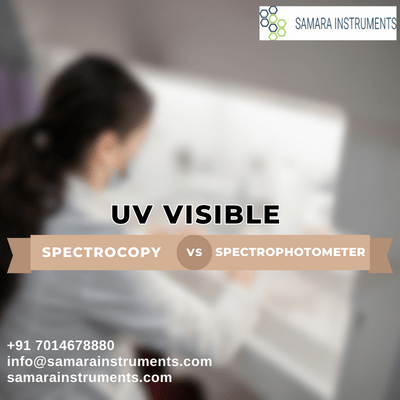UV Visible Spectroscopy vs UV Visible Spectrophotometer
UV visible spectroscopy is a powerful analytical technique that uses the absorption of ultraviolet (UV) and visible (Vis) light by molecules to gain insights into their structure, composition, and interactions. UV-visible spectrophotometers are the instruments used to measure this absorption.
Understanding UV-Visible Spectroscopy
When UV-visible light interacts with a molecule, some of the light energy can be absorbed by the molecule. The amount of light absorbed depends on the wavelength of the light and the structure of the molecule. Each molecule has a unique absorption spectrum, which is a plot of the absorbance of light at different wavelengths.
The absorption of UV-visible light by molecules can be used to determine their concentration, identify them, and study their chemical properties. For example, the absorption of UV light by proteins can be used to determine their concentration, and the absorption of visible light by chlorophyll can be used to identify plants.
The Role of UV-Visible Spectrophotometers
UV-visible spectrophotometers are the instruments used to measure the absorption of UV-visible light by molecules. They consist of a light source, a monochromator, a sample holder, and a detector.
The light source emits a beam of light that is passed through the monochromator. The monochromator disperses the light into its component wavelengths, and a specific wavelength is selected and passed through the sample holder. The sample absorbs some of the light, and the remaining light is detected by the detector.
The detector measures the intensity of the light that passes through the sample, and this information is used to create an absorption spectrum.
Applications and Advancements
UV-visible spectroscopy is a versatile technique with a wide range of applications. It is used in many different fields, including chemistry, biology, medicine, and environmental science.
Some of the common applications of UV-visible spectroscopy include:
- Identifying and quantifying chemicals
- Studying the structure of molecules
- Determining the concentration of solutions
- Monitoring chemical reactions
- Measuring the purity of products
- Analyzing food and beverages
- Diagnosing diseases
UV-visible spectroscopy is a powerful tool that can be used to gain insights into the molecular world. Recent technological advancements have made UV-visible spectrophotometers more sophisticated and versatile, expanding their range of applications.
UV-visible spectroscopy and UV-visible spectrophotometers are essential tools for researchers and scientists. These techniques provide a wealth of information about molecules, and they are used in a wide variety of fields. As technology continues to advance, UV-visible spectroscopy is poised to become even more important in the years to come.


